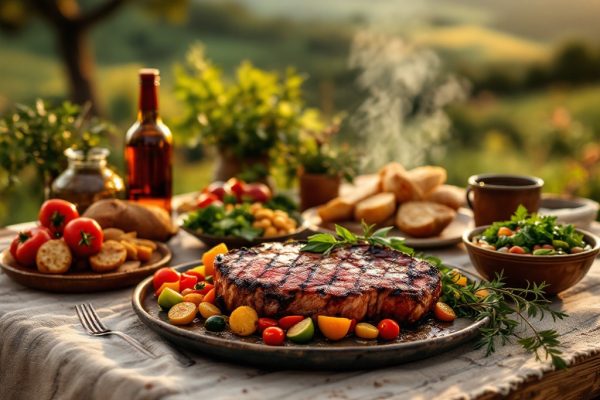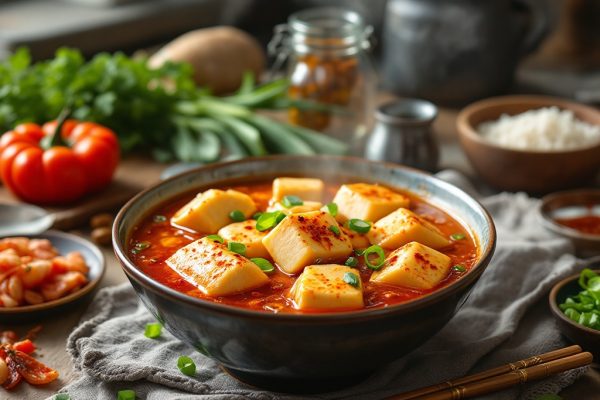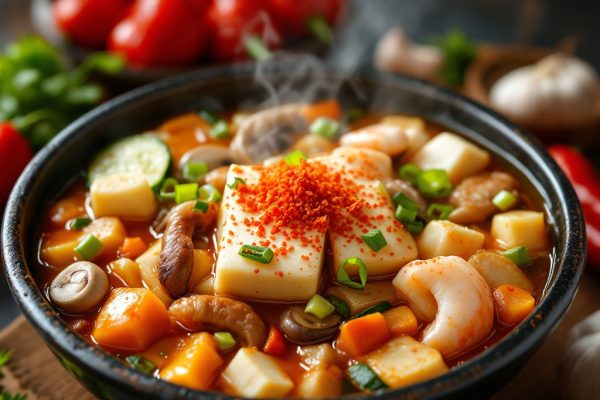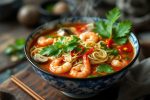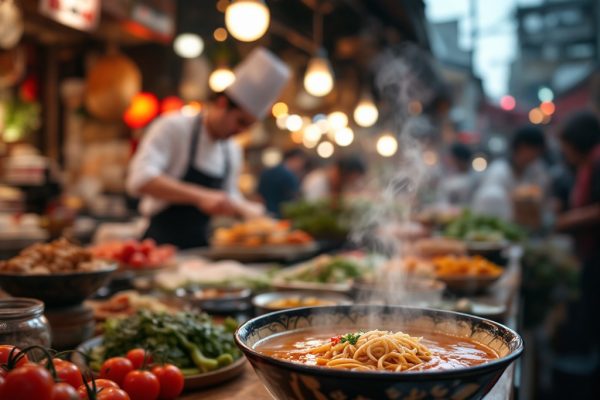Traditional Curry Spices List for a Perfect Indian Flavor
Unlock the secrets of authentic Indian flavor! Discover the magic of traditional curry spices, from the warm earthiness of cumin and coriander to the vibrant hue of turmeric. Learn how to blend these aromatic spices, along with potent additions like garam masala and amchur powder, to create delicious curries at home. Explore regional variations and spice preferences across India, and embark on a culinary journey that tantalizes your taste buds. Start creating your own signature curry powder today!
Important information

- Core curry powder blends usually have coriander, cumin, turmeric, and chili powder.
- Garam masala, a key spice blend, adds depth and aroma to Indian dishes.
- Making curry powder at home lets you control the spices and avoid additives.
- Toasting whole spices before grinding enhances their flavor in curry.
- Indian cuisine varies by region, with different spice preferences and cooking styles.
Key Spices in Traditional Indian Curry
Turmeric gives Indian curry its vibrant golden color. Cumin adds warmth, while coriander brings citrusy and nutty notes. Kashmiri chili powder provides a gentle heat, and mustard seeds offer a pungent kick. Asafetida contributes a savory, earthy flavor, while amchur powder delivers a tangy zest.
- Turmeric: provides vibrant golden color,
- Cumin: adds warmth,
- Coriander: brings citrusy and nutty notes,
- Kashmiri chili powder: provides a gentle heat,
- Mustard seeds: offer a pungent kick,
- Asafetida: contributes a savory, earthy flavor,
- Amchur powder: delivers a tangy zest.
These key spices are often combined with complex blends like garam masala, which further enhances the dish with cardamom, cloves, cinnamon, and other aromatic spices. This creates the symphony of flavors that makes Indian curry so unique.
Turmeric: The Golden Spice
Turmeric gives curry powder its warm, slightly bitter taste and bright yellow color, thanks to curcumin. This powerful antioxidant and anti-inflammatory compound is key to authentic Indian curry.
Cumin: Earthy and Warm
Cumin is a cornerstone of Indian cuisine, lending its warm, earthy notes to a wide array of dishes, particularly curries. You’ll encounter it both whole and ground, with toasting the seeds before grinding significantly intensifying their inherent flavor. This process unlocks the aromatic complexity characteristic of many Indian curries.
Ground cumin frequently partners with coriander, creating a dynamic duo that adds depth and enhances the overall taste of any dish.
Coriander: Citrus and Nutty
Coriander, derived from the cilantro plant, adds bright, citrusy notes and a subtle nuttiness to dishes. It balances the heat of other spices, especially in curries. Ground coriander seeds offer warm, earthy undertones. Fresh cilantro leaves provide a refreshing counterpoint. Both enhance the complexity and aroma of Indian cuisine. Coriander is often paired with cumin for a balanced flavor profile. It is a staple in numerous dishes, including curries, stews, and soups.
Coriander is also a key ingredient in spice blends like garam masala.
Kashmiri Chili Powder: Mild Heat and Color
Kashmiri chili powder is a staple in Indian cuisine, lending its vibrant red color and mild heat to iconic dishes like butter chicken, tikka masala, and biryani. Beyond its rich hue, it imparts a subtle smoky flavor, enhancing curries, sauces, and marinades without overwhelming the palate. Its gentle spiciness contributes to a balanced flavor profile, making it a truly versatile spice.
Garam Masala: A Complex Blend
Garam masala, a cornerstone of Indian cuisine, is a blend of ground spices typically added at the end of cooking to preserve its aromatic fragrance. Common ingredients include cinnamon, cloves, black cardamom, nutmeg, and black pepper, creating a warm, deep flavor. Garam masala is distinct from curry powder. Curry powder is a pre-mixed blend often used earlier in cooking, such as in marinades, and offers a different flavor profile.
The precise blend of garam masala varies, giving each iteration its own unique character.
Mustard Seeds: Pungent and Sharp
Mustard seeds, tiny and round, come from the mustard plant and bring a pungent bite and pleasing texture to curries. Chefs often “temper” these seeds. This involves briefly frying them in hot oil to release their strong flavor, creating a base for other curry ingredients. This enhances the overall dish.
Asafetida: Savory and Earthy
Asafoetida, also known as hing, is a key spice in Indian cuisine, celebrated for its pungent, sulfurous aroma. Despite its initial strong smell, it adds a savory, umami flavor, enhancing dishes with just a small amount.
It is often added to hot oil or lentil-based recipes. Asafoetida not only elevates the taste but also aids digestion. This versatile spice comes from the resin of a giant fennel plant. It is available in both powder and resin forms.
Amchur Powder: Tangy and Fruity
Amchur powder, derived from dried, unripe mangoes, adds a tangy, fruity flavor that perfectly complements rich Indian curries. Its tartness balances the sweetness and heat, making it a popular addition to chutneys, marinades, and spice blends. This versatile ingredient also brings a unique sour note to various dishes, enhancing the complexity of Indian cuisine.
Other Essential Spices: Clove, Cardamom, Bay Leaves, Ginger, Garlic, Cinnamon
Indian cuisine is famous for its masterful use of spices. These spices create flavorful sensations, transforming ordinary curries into extraordinary culinary experiences.
Some key spices include clove, cardamom, bay leaves, ginger, garlic, and cinnamon. Clove adds warmth and sweetness. Cardamom brings a fragrant citrusy zest. Bay leaves contribute a subtle herbal and minty aroma. Ginger delivers a pungent kick. Garlic provides savory depth. Cinnamon offers a warm sweetness. The combination of these spices creates a complex interplay of flavors, where each spice complements and balances the others. Clove’s warmth enhances cardamom’s brightness. Ginger’s heat is offset by garlic’s savory character. The bay leaves add a unique herbal dimension. Each spice plays a crucial role in the overall flavor profile.
The Art of Cooking with Traditional Curry Spices
Cumin provides an earthy base, while coriander adds citrusy and nutty notes. Turmeric lends warmth and a rich golden hue, and chili powder delivers the heat. Garam masala, a complex blend, contributes depth and aroma. Other spices further enhance the flavor profile: pungent mustard seeds, savory asafetida, and tangy amchur powder.
Starting with Whole Spices in Medium Hot Oil
Blooming whole spices in hot oil releases their aromatic complexity, forming a flavorful foundation for many Indian dishes. Cumin and mustard seeds are common examples.
Frying Fragrant Spices for Flavor Release
The sizzle of hot oil releases the captivating fragrance of spices, a process called blooming or tempering. This intensifies their flavors, creating a rich base for the dish and significantly enhancing the curry’s overall taste. This simple step makes a remarkable difference.
Adding Spice Powders at the Right Time
Add spice powders later in the cooking process to enhance their flavor and prevent burning. This allows the dish to develop a richer, more well-rounded taste.
Creating Homemade Curry Powder
Create your own fresh and flavorful curry powder! You’ll have complete control over the taste with a simple process.
Combine spices like turmeric, cumin, coriander, and chili powder.
For optimal flavor, start with whole spices, blend them, and then grind them into a powder.
Unlike store-bought versions, homemade curry powder allows you to customize the blend to your preferences, creating a healthier option without additives or preservatives. Experiment with unique blends by adding ginger or cardamom, and consider roasting some spices beforehand for a deeper, richer flavor. Just be careful not to burn them.
Benefits of Homemade Curry Powder
Homemade curry powder bursts with freshness, offering a depth of flavor unmatched by store-bought versions. You’re in charge, customizing the spices and heat level to suit any dietary need or palate. The secret lies in freshly ground spices, which retain their aromatic oils for a vibrant, flavorful curry.
As a bonus, crafting your own blend saves money; buying individual spices is often more economical. Experiment and discover your signature curry, perfectly tailored to each unique dish.
Steps to Make Your Own Curry Powder
Choose your spices. Popular options include turmeric, cumin, coriander, Kashmiri chili powder, and garam masala. Consider adding mustard seeds, asafetida, and amchur powder for a tangy kick. Clove, cardamom, bay leaves, ginger, garlic, and cinnamon can further enhance the blend.
For a richer flavor, toast the spices. Dry roast them in a pan over medium heat until fragrant, intensifying their aromas and taste.
Once cooled, grind the spices into a fine powder using a mortar and pestle or a spice grinder.
Store the curry powder in an airtight container in a cool, dark place to preserve its freshness.
Regional Variations in Indian Cooking
Coastal areas like Kerala and Goa use coconut milk and seafood, resulting in light, flavorful dishes. Eastern India features mustard oil and freshwater fish, creating a distinct flavor profile.
- Kerala and Goa: coconut milk and seafood create light dishes.
- Eastern India: mustard oil and freshwater fish create a distinct flavor.
Northern India favors rich, creamy curries cooked in tandoor ovens, producing delicacies like naan and tandoori chicken. Western India incorporates lentils and vegetables into drier curries. Southern India emphasizes rice, tamarind, lentils, and a medley of spices.
- Northern India: rich curries, tandoor-cooked dishes like naan and tandoori chicken.
- Western India: lentils and vegetables in drier curries.
- Southern India: rice, tamarind, lentils, and spices.
Understanding Regional Spice Preferences
India’s diverse culinary landscape is a testament to its regional spice preferences.
Kashmir
Kashmiri cuisine often features fennel, ginger, and asafoetida.
Goa and Kerala
Coastal regions like Goa and Kerala favor coconut, chilies, and curry leaves.
North India
Dishes from North India rely heavily on garam masala, cumin, and coriander.
West India
Western India is distinguished by a unique sweet and spicy flavor profile, often created with jaggery and chili powder.
East India
The east incorporates mustard seeds, poppy seeds, and panch phoron.
These distinct combinations reflect not only local ingredients but also cultural influences and historic trade routes.
Adapting Spices for Different Indian Regions
Indian cuisine offers a diverse range of flavors, varying significantly across regions. Here’s a glimpse into the distinct spice profiles:
Kashmiri Cuisine
Features aromatic spices like fennel, ginger, and cloves.
South Indian Cuisine
Characterized by the distinct taste of curry leaves, mustard seeds, and fenugreek.
Gujarati Cuisine
Offers a sweeter experience, often using cinnamon, nutmeg, and sugar.
East Indian Cuisine
Known for the bold flavors of mustard oil, poppy seeds, and green chilies.
West Indian Cuisine
Emphasizes warm, earthy flavors with cumin, coriander, and turmeric.




